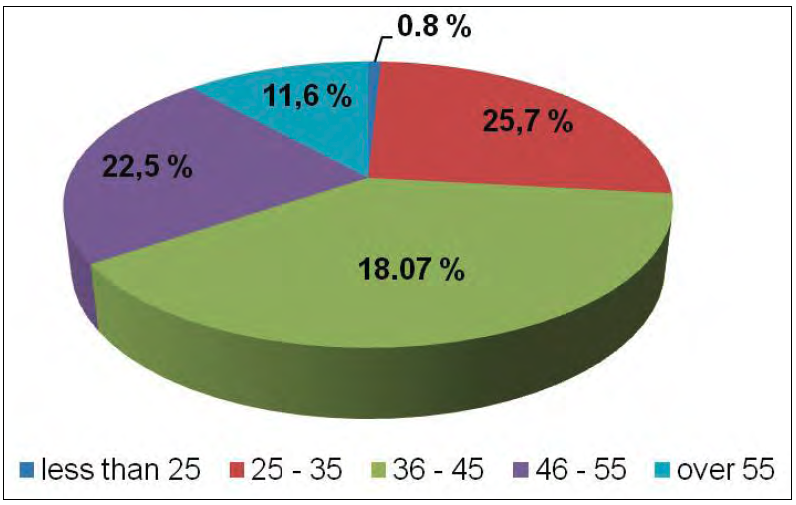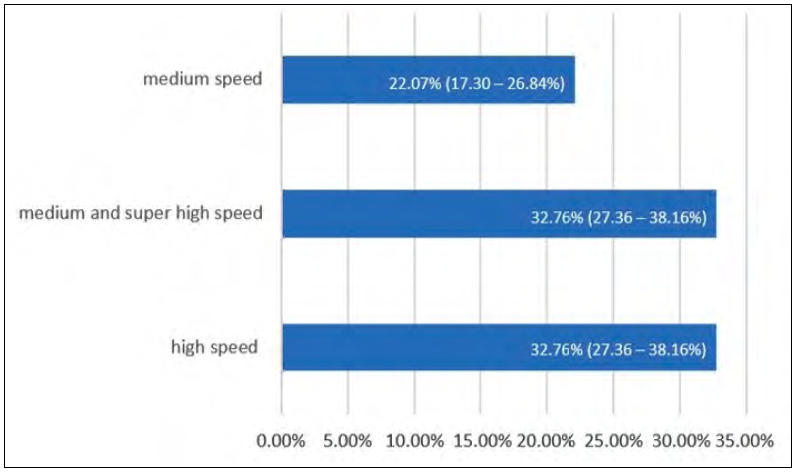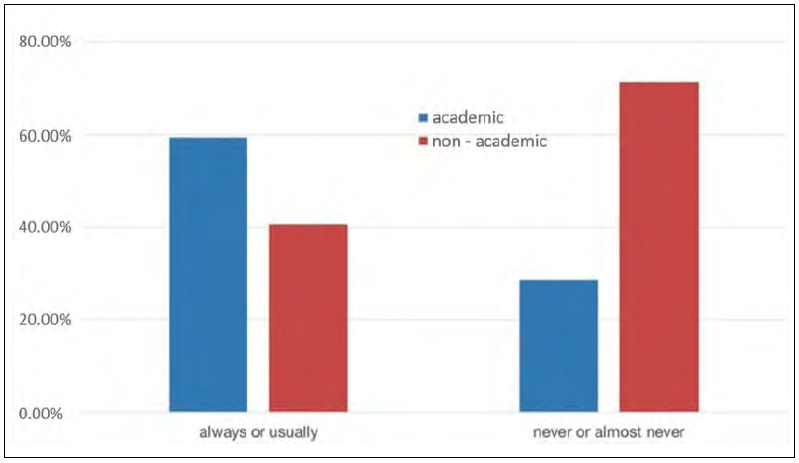INTRODUCTION
The removal of caries-affected tissues is one of the most frequent procedures in daily dental practice. The aim of using different combinations of speed, pressure and type of cutting instrument is to achieve maximum cutting power without causing biological damage to the pulp. The hydroxyapatite in the dentine is a fragile material, so it requires less energy to produce fracture, while the collagen matrix is a soft material and the way it is cut is guided by different principles, like those of ductile materials. Although this maneuver can be performed using either manual or rotary instruments, the literature currently recommends the use of plain cut round burs, whose size is chosen in relation to the size of the lesion at low, medium or high speed1-3.
There are different forms and brands of dental burs as well as commercial recommendations, detailed information about cleaning, disinfection and sterilization. However, data about the recommended number of uses is often unreported. Some authors such as Morrison and Corond8, report that the life of a dental bur is limited to no more than five or six sterilization cycles because it becomes distempered and loses its cutting edge, thus beginning to require greater working pressure with the consequent generation of heat and deleterious effect on the pulp. Sterilization of dental instruments, including burs, for reuse occurs regularly in all dental offices in order to minimize the risk of cross contamination between patients. The methods used for both cleaning and decontamination and for sterilization significantly reduce the durability and resistance of burs5,6. Regarding the use of the rubber dam, some authors indicate that the rate of its usage by general dentists is 37% - 43%7,8, while Siegel and von Fraunhofer9 report that 63% refer to using it. Another publication found that professionals with 5 to 10 years' work experience had the highest rate (76.3%), while professionals with more than 20 years of practice had the lowest rate (53.2%). Endodontists had the highest and most frequent use rate9.
Two different studies analyzed the behavior and attitudes of students from the United States of
America and health professionals in India regarding the use of different types of burs for tissue removal during caries treatment8,10,11, finding that most professionals in India preferred diamond burs, while students in different dental schools in the United States used tungsten carbide burs. In these studies, most dentists said they use the burs until they wear out (85%), sterilize them once a day (35%) or after each patient (35%).
The aim of this study was to collect information about the habits of members of the dental community in Argentina regarding the use and conditioning of dentin removal burs in the treatment of carious lesions.
MATERIALS AND METHODS
A 14-item questionnaire was prepared in Google Forms platform, with an informed consent inserted at the beginning and anonymity set as selection criteria. Once validated in small groups, the relevant authorizations were processed and the questionnaire was sent to three lists of dental subscribers through the computer services area of the School of Dentistry, University of Buenos Aires, Argentina (FOUBA). According to information provided by the aforementioned area, the lists consisted of 8478 dentists, of whom 1555 were also faculty members and 27 were full professors. By the deadline for receiving responses, which was set as four weeks after the sending date, 294 replies were received. Data was analyzed by rates with 95% confidence intervals and chi-square test (significance level: P<0.05).
RESULTS
After four weeks, 294 replies were received, of which 47.93% (42.18-53.68%) claimed to be members of faculty and 37.24% (31.68-42.81%) claimed to teach at FOUBA (Fig. 1).
Regarding area of specialization, most respondents reported disciplines related to the indispensable use of burs for caries treatment such as restorative dentistry, endodontics or prosthetic dentistry, as well as pediatric dentistry.
In terms of age, 26.90% (21.79-32.00%) reported being under 35 years old, 37.59% (32.01-43.16%) 36 to 45, 22.07% (17, 30-26.84%) 46 to 55 and 11.38% (7.72-15.03%) over 55 years (Fig. 2).
About 22.07% (17.30-26.84%) reported that they remove carious dentin with medium speed rotary instruments, while 32.76% (27.36-38.16%) reported using super-high speed and 32.76 % (27.36-38.16%) a combination of both (Fig. 3). This item had significantly different responses as a function according to academic involvement (P<0,01). Around 31% (23.55%-39.59%) of the dentists who also identified themselves as faculty members claimed to employ medium speed, 20.59% (13.93%-27.97%) ultra-high speed and 34.56% (26.21%-42.61%) both speeds. On the other hand, non-academic respondents answered 14.19%, (9.00%-20.87%), 44.59% (36.43%-52.98%) and 32.43% (24.98%-40.61%), respectively.
In terms of main use, removal of carious dentin was the most frequently mentioned. Among surveyed dentists, 68.07% (62.31%-73.44) declared that they use round burs and 27.72% (22.60%-23.31%) associate round burs with another means. This was not found to depend on whether or not the respondents belonged to the academia (P>0.05). Faculty members referred to using dental burs with absolute isolation always or almost always in 74.82% (67.60-82.04%) of the cases, while amongst respondents from outside the academic field, 51.01% (42.98-59.03%) answered that they never or almost never do so (P <0.001) (Fig. 4).
Only 17.93% (13.52-22.35%) indicated that they keep a record of the number of times they use burs, while 50.34% (44.59-56.10%) of the respondents said that they use burs "until they no longer cut", and 23.79% (18.89-28.69%) of total respondents claim they use burs 1 to 5 times.
Table 1) summarizes the quantity and quality of devices and solutions claimed to be used during cleaning, decontamination and sterilization of burs. Overall, 98.27% (96.77-99.77%) said they clean their burs once used, 44.68% (38.80-50.70%) reported using three conditioning methods for burs, while 28.72% (23.50-34.40%) stated using two, and 19.15% (14.70-24.20%) four of them. Only about 4% selected only one 3.90% (2.00-6.90%) or five methods 3.55% (1.70-6.40%). The two most frequently selected single cleaning, decontamination or sterilization methods were metal brush, 94.33% (90.90-96.70%) and enzymatic solution, 92.55% (88.80-95.30%). Of the 28.72% (23.50-34.4%) that selected 2 modes, mechanical brush, 96.30% (89.6099.20%) and enzymatic solution, 88.89% (80.0094.80%) were the most frequently chosen methods to combine. Within the 44.68% (38.80-50.70%) that selected 3 modes, mechanical brush, 99.21% (95.70-100.00%), enzymatic solution, 98.41% (94.40-99.80%), autoclave, 34.92% (26.60-43.90%) and stove, 29.37% (21.60-38.10%) were the most frequently indicated to be used in association.

Table 1 Responses regarding number of cleaning modes employed and devices/solutions preferred. Rates and IC95%
Of the 19.15% (14.70-24.20%) that selected 4 modes, metal brush, 98.15% (90.10-100.00%), enzymatic solution, 98.15% (90.10-100.00%), autoclave, 51.85% (37.80-65.70%), sodium hypochlorite, 40.74% (27.60-55.00) and stove, 38.89% (25.90-53.10%) were the most frequently indicated.
DISCUSSION
Although the removal of dentin affected by caries is one of the most frequent procedures in the daily practice of dentistry, the literature contains few studies about the attitudes of dental practitioners and faculty members regarding selection and management methods of instruments used for removal of infected dentin. Of the dentists who responded the survey in this study, 97.28% said they clean or condition the burs, in contrast to 70% of the participants in the study by Sharma et al10. Regarding how many times a bur is used, although there is evidence in the literature that supports that an optimal limit is within five times, most of the respondents declared that they use them "until they no longer cut" in agreement with the paper by Sharma10 that explored the same variable in a group of Hindu dentists. With respect to the use of rubber dam, 62.1% of our respondents stated that they always or almost always use it, unlike the findings of Imberly and Carrico8, who indicate that 37 - 43% of dentists use it. A separate analysis comparing academic and non-academic respondents shows that the rates reported by nonacademics are similar to those found by Imberly and Carrico8. Metal brush and enzymatic solutions were the most frequently mentioned in one and two mode cleaning methods. When respondents referred to use three or more cleaning methods, stove, autoclave and ultrasound were the devices added to the protocols.


















